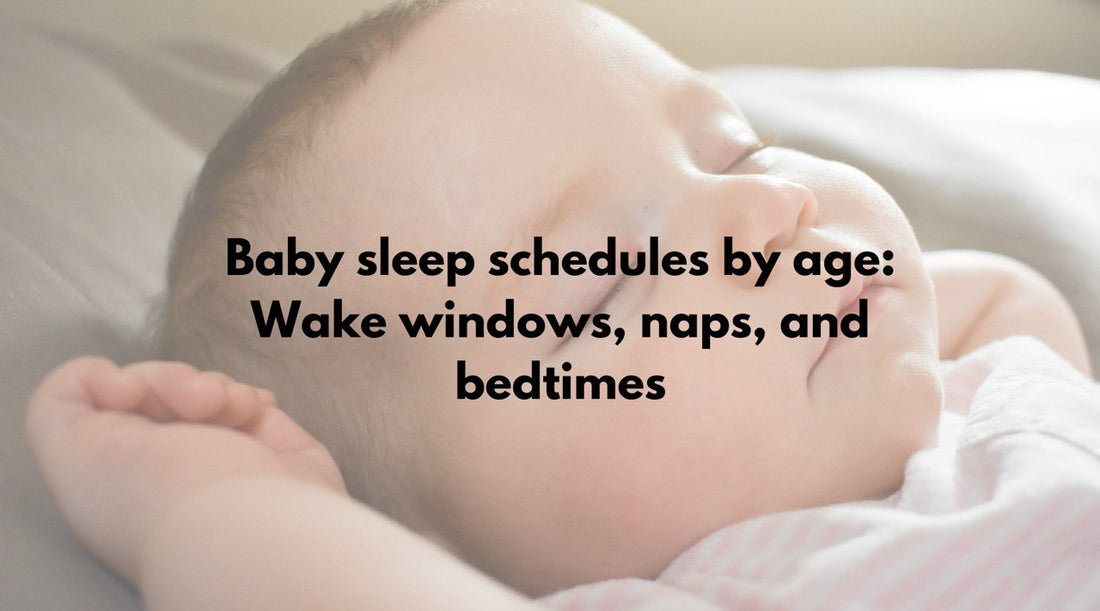
Baby sleep schedules by age: Wake windows, naps, and bedtimes
Share
Babies change rapidly in their first years—sleep needs included. Once the newborn haze passes, most little ones become ready for a more predictable, age-appropriate rhythm. Use the guides below to set expectations for wake windows, naps, and total sleep so your child gets the rest they need.
Editor’s note
These ranges reflect typical averages. Some children naturally need a bit more—or a bit less—sleep. If your child was born early, use their adjusted age when gauging sleep development.
When can you start a baby sleep schedule?
In the first weeks, sleep is irregular, and that’s developmentally normal. Newborns don’t have organized sleep cycles yet, so strict schedules aren’t practical. Around 3–4 months, many babies begin to follow a more recognizable 24-hour pattern for eating and sleeping (though short naps are still common). Most aren’t ready for consistent, “by-the-clock” nap and bedtime targets until about 6 months.
Expect to revisit the schedule regularly. As wake windows lengthen, babies drop naps and shift bedtimes. A consistent bedtime routine—adapted as your child grows—helps signal that sleep is coming, even before a true schedule is possible.
Baby sleep schedules by age
Use these tables as starting points. Watch your child’s mood and energy to judge if they’re well rested. Bring concerns to your pediatrician.
First year
Newborns (0–2 months)
Flexibility rules here. Naps can be 30 minutes…or 2 hours. Bedtime is often late and variable. Follow short wake windows and sleepy cues.
|
Age |
Avg total sleep |
Naps |
Goal daytime sleep |
|
< 1 month |
~15.5 h |
Varies |
Varies |
|
1 week |
~15.5 h |
Varies |
Varies |
|
2 weeks |
~15.5 h |
Varies |
Varies |
|
3 weeks |
~15.5 h |
Varies |
Varies |
|
1 month |
~15.5 h |
Varies |
Varies |
|
5–7 weeks |
~15.5 h |
Varies |
Varies |
|
2 months |
~15.5 h |
4–5 |
5–6 h |
3–5 months
Sleep starts to look more predictable. Many babies move from 4 naps to 3.
|
Age |
Avg total sleep |
Naps |
Goal daytime sleep |
|
3 months |
~15 h |
4–5 |
4–5 h |
|
4 months |
~14.5 h |
3–4 |
3.5–4.5 h |
|
5 months |
~14.5 h |
3–4 |
2.5–3.5 h |
6–8 months
Three-nap days are common at 6 months; by 8–9 months many drop to two naps.
|
Age |
Avg total sleep |
Naps |
Goal daytime sleep |
|
6 months |
~14 h |
3 |
2.5–3.5 h |
|
7 months |
~14 h |
2–3 |
2.5–3.5 h |
|
8 months |
~14 h |
2–3 |
2–3 h |
9–12 months
Two solid naps become the norm; bedtimes are easier to keep consistent.
|
Age |
Avg total sleep |
Naps |
Goal daytime sleep |
|
9 months |
~14 h |
2 |
2–3 h |
|
10 months |
~13.5 h |
2 |
2–3 h |
|
11 months |
~13.5 h |
2 |
2–3 h |
|
12 months |
~13.25 h |
2 |
2–3 h |
Second year
13–15 months
Many start the gradual shift from 2 naps to 1. Offer two naps; use an earlier bedtime if naps are short or a nap is skipped.
|
Age |
Avg total sleep |
Naps |
Goal daytime sleep |
|
13 months |
~13.25 h |
2 |
2–3 h |
|
14 months |
~13.25 h |
1–2 |
2–3 h |
|
15 months |
~13 h |
1–2 |
2–3 h |
16–18 months
If still on two naps, most drop to one during this window.
|
Age |
Avg total sleep |
Naps |
Goal daytime sleep |
|
16 months |
13–14 h |
1–2 |
2–3 h |
|
17 months |
13–14 h |
1–2 |
2–3 h |
|
18 months |
13–14 h |
1 |
2–3 h |
19–21 months
Typically one midday nap, starting ~5 hours after morning wake. If afternoons run long, use an earlier bedtime to prevent early morning wakes.
|
Age |
Avg total sleep |
Naps |
Goal daytime sleep |
|
19 months |
~13 h |
1 |
2–3 h |
|
20 months |
~13 h |
1 |
2–3 h |
|
21 months |
~12.5 h |
1 |
1.5–2.5 h |
22–29 months
Around age 2, many do best with a slightly longer morning wake window (about 5.25–6 hours) before the nap. Add 10–15 minutes of wind-down before bedtime if settling is slow.
|
Age |
Avg total sleep |
Naps |
Goal daytime sleep |
|
22–23 months |
~12.5 h |
1 |
1.5–2.5 h |
|
24–29 months |
~12 h |
1 |
1.5–2.5 h |
30 months to 5 years
Expect big transitions: dropping the nap, leaving the crib, saying goodbye to pacifiers. A steady routine and age-appropriate timing smooth these changes.
|
Age |
Avg total sleep |
Naps |
Goal daytime sleep |
|
30 months |
~12 h |
1 |
1–2 h |
|
3 years |
11.5–12 h |
0–1 |
1–1.5 h if napping |
|
4 years |
11.5–12 h |
0–1 |
1–1.5 h if napping |
|
5 years |
11.5–12 h |
0 |
— (use earlier bedtime) |
Takeaway
Newborns: highly variable sleep; follow short wake windows and cues.
3–4 months: 24-hour patterns emerge; short naps still common.
~6 months+: most babies can follow more predictable, clock-based schedules.
Throughout the first years: wake windows lengthen → naps consolidate and drop.
Keep watching your child’s cues and mood, and adjust as they grow.
